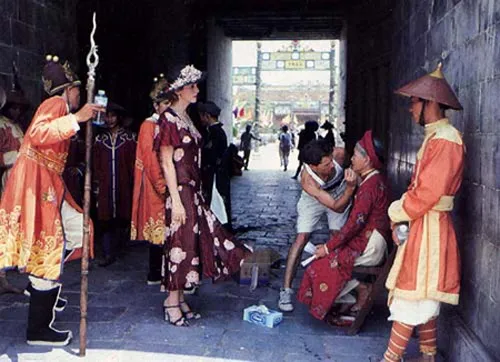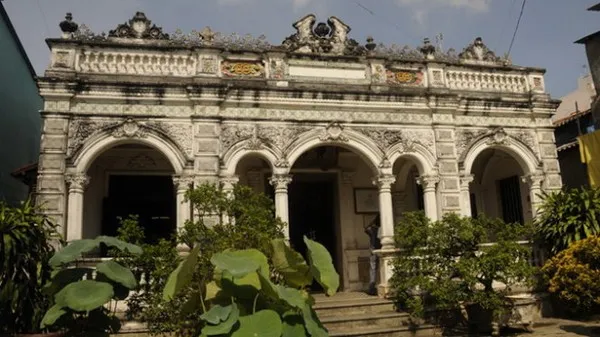Vietnam, with its majestic natural beauty and unique culture, has become an attractive destination for filmmakers both domestically and internationally. From heroic historical epics to fantastical scenes, Vietnam has contributed to the success of many famous cinematic works. Join “Du lịch khắp thế gian” to discover renowned filming locations where cinema and Vietnamese beauty intertwine, offering unforgettable experiences for audiences.
Ha Long Bay: The Emerald Jewel of World Cinema
Ha Long Bay, a UNESCO-recognized World Natural Heritage site, has long been a tourism symbol of Vietnam. Not only attracting tourists with its magnificent beauty of thousands of limestone islands rising from the blue waters, Ha Long is also an endless source of inspiration for filmmakers.
The uniquely shaped islands and fantastical cave systems have created spectacular settings, contributing to the success of many famous films. Ha Long Bay appeared in the movie “Indochine” (1992), a French film that won numerous prestigious awards.

Moreover, Ha Long also featured in the movie “Pan” by director Joe Wright, bringing to life a magical Neverland world with towering limestone mountains. Most recently, Ha Long Bay was also one of the main settings for the blockbuster “Kong: Skull Island,” attracting the attention of the global film industry.
Ninh Binh: Majestic Beauty in Historical Films
Ninh Binh, a land of “picturesque mountains and waters” with magnificent limestone ranges, lush green rice paddies, and winding rivers, has become a familiar destination for Vietnamese historical film crews. The majestic beauty of Ninh Binh has contributed to creating heroic historical films, recreating important historical periods of the nation.
In recent years, Ninh Binh has become increasingly known through famous films such as “Thien Menh Anh Hung” (Blood Letter). The hidden beauty of this land has also been quickly discovered by foreign filmmakers, who have chosen it as an outdoor filming location for many major film projects.
Also in “Pan,” the image of green rice fields with a winding river along the mountainside in Ninh Binh was used as the setting for Mermaid Lagoon. In “Kong: Skull Island,” the film crew chose Trang An, Tam Coc – Bich Dong, and Van Long Lagoon as settings for many important scenes. Previously, Ninh Binh also appeared in “The Quiet American,” and Phat Diem Cathedral in “Indochine.”
Quang Binh: The Magnificent Kingdom of Caves on the Big Screen
Quang Binh, a small central province, has become famous on the world tourism map thanks to the majestic beauty of Son Doong Cave, the largest cave in the world. Impressive images of Son Doong have been published in many prestigious magazines, attracting the attention of a large audience. Even the American television channel ABC News broadcasted “Good Morning America” live from Son Doong Cave in 2015.

“Kong: Skull Island” also chose Quang Binh as one of its main filming locations. The film crew shot many scenes in pristine areas with forests and majestic limestone mountains such as Thuong Hoa, Yen Hoa, Tu Lan… Veteran actor Samuel Jackson also shared selfies at the filming location, attracting the attention of the online community.
Prior to that, the entrance to En Cave – the 3rd largest cave in the world in Quang Binh – also appeared in a rather lengthy, important, and exciting scene in “Pan.” To capture this image, from mid-2014, 10 film experts came to En Cave to film in 3D, take photos, and record the structure inside the cave to create post-production sets for the film.
Hue: Ancient Imperial City in Historical Films
Hue, the last capital of the Vietnamese feudal dynasty, still preserves almost intact ancient architectural works. Therefore, Hue is often chosen as a film studio for movies with content about kings and dynasties.

In 1989, director Régis Wargnier of the movie “Indochine” came to Vietnam to scout locations for his film. The film crew was allowed to film in palaces and tombs in the Hue Imperial Citadel. The local authorities even allowed the film crew to stage scenes in Emperor Bao Dai’s palace.
Sa Dec: The Mark of “The Lover”
Sa Dec, a small city in the Mekong Delta, is famous for its ancient houses and peaceful beauty. This place became the main setting for the movie “The Lover” (L’Amant), based on the novel of the same name by French writer Marguerite Duras.
The film tells the story of a love affair between a young French girl and a wealthy Chinese man in Vietnam in the 1930s. The ancient house of Huynh Thuy Le, where the passionate love story of the two main characters took place, is now an attractive destination for domestic and international tourists.

The house once belonged to Mr. Huynh Thuy Le, the lover of writer Marguerite Duras in her youth. After the war, the house was taken over by the Vietnamese government and used as a police headquarters. Recently, it has been opened to tourists.
Vietnam: An Attractive Destination for World Cinema
Vietnam, with its diverse natural beauty and rich culture, is increasingly asserting its position as an attractive destination for world cinema. From historical and cultural films to action and adventure works, Vietnam has contributed to the success of many international film projects.
With great tourism and film potential, Vietnam promises to continue to be an ideal destination for filmmakers in the future. Join “Du lịch khắp thế gian” to discover and experience the unique beauty of Vietnam through the lens of cinema!